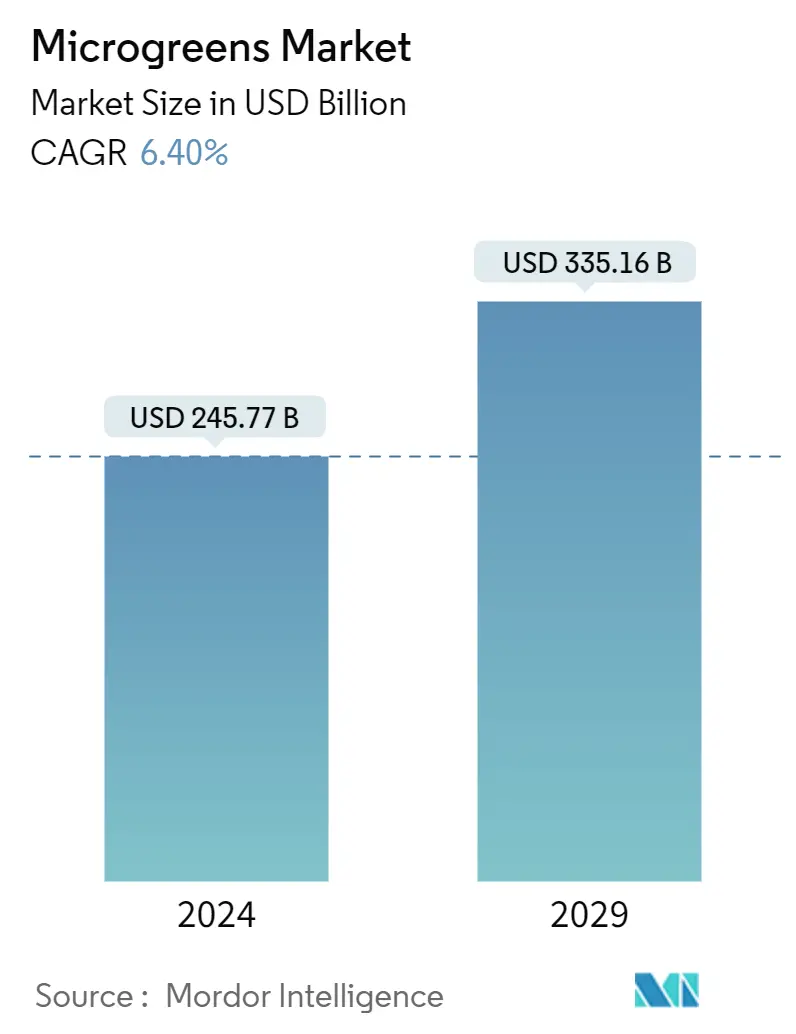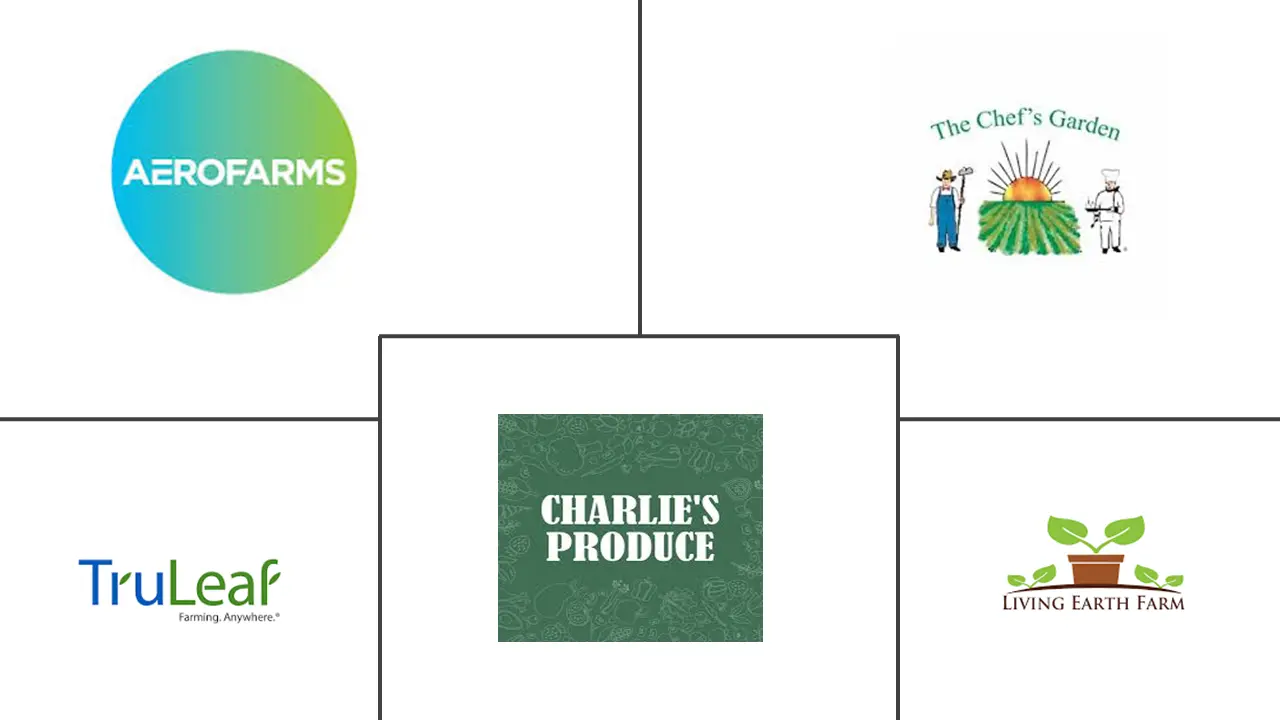Market Size of Microgreens Industry

| Study Period | 2019 - 2029 |
| Market Size (2024) | USD 245.77 Billion |
| Market Size (2029) | USD 335.16 Billion |
| CAGR (2024 - 2029) | 6.40 % |
| Fastest Growing Market | Asia Pacific |
| Largest Market | North America |
| Market Concentration | Low |
Major Players
*Disclaimer: Major Players sorted in no particular order |
Microgreens Market Analysis
The Microgreens Market size is estimated at USD 245.77 billion in 2024, and is expected to reach USD 335.16 billion by 2029, growing at a CAGR of 6.40% during the forecast period (2024-2029).
- Microgreens are small, tender vegetable greens used to enhance the color, texture, and flavor of various dishes, including pasta, pizza, omelets, and salads. Their robust aromatic flavor, diverse range of colors, and textures make them popular in culinary applications. Consuming microgreens is associated with health benefits such as weight management, prevention of chronic medical conditions, immunity boosting, and mental health improvement.
- The global trend towards healthier eating habits and increased nutritional awareness continues to drive the microgreens market. Consumers, particularly in urban areas, have become more informed about the high nutrient density of microgreens compared to their mature counterparts. A study published in the International Journal of Home Science found that microgreen varieties contained up to 40 times more nutrients than their mature plant equivalents. Consequently, major supermarket chains in countries such as the United States, United Kingdom, and Australia have expanded their microgreens offerings.
- To meet the growing demand, investments are being made in advanced hydroponic systems that utilize artificial intelligence and smart sensors to optimize growth conditions. Aa a result, there is significant growth in greenhouse hectares for cultivation. For instance, according to the European Commission, the area under greenhouses in Spain reached 25,000 ha and in Italy 18,500 ha in 2023. Companies like Freight Farms are maximizing output by integrating microgreens into their production cycles in vertical farms, utilizing existing space. These microgreens can yield between 0.001 to 0.002 metric tons per tray, generating significant revenue.
- While greens and herbs or microgreens are among the most profitable crops, the limited varieties available for indoor farming may restrict market growth. Although hydroponics farming holds significant potential, its progress and adoption in agriculture have been relatively slow.
- Broccoli, lettuce, arugula, and basil are among the essential microgreens cultivated worldwide using hydroponics and vertical farming techniques. The demand for microgreens is increasing in developed countries, as they can be cultivated indoors throughout the year. According to the United States Fresh Produce Association, the likelihood of consumers purchasing broccoli microgreens increases with income and age. With a growing population, microgreens offer a nutritious and sustainable means to diversify the food supply, which is expected to drive market growth.
Microgreens Industry Segmentation
Microgreens are shoots of salad vegetables picked just after the first leaves have developed. They have fully grown cotyledon leaves and, usually, one pair of very small, partially produced true leaves. They are cultivated using various kinds of farming, such as vertical farming, indoor farming, and commercial greenhouses. The microgreens market is segmented by type (broccoli, lettuce and chicory, arugula, basil, fennel, carrots, sunflower, radish, peas, and other types), farming (indoor farming, vertical farming, commercial greenhouses, and other farming), growth medium (coconut coir, peat moss, soil, tissue paper, and other growth mediums), distribution channel (hypermarkets/supermarkets, restaurants, and other distribution channels), and geography (North America, Europe, Asia-Pacific, South America, and Middle East & Africa). The report offers the market size and forecasts in terms of value (USD) and volume (Metric Tons) for the above-mentioned segments.
| Type | |
| Broccoli | |
| Lettuce and Chicory | |
| Arugula | |
| Basil | |
| Fennel | |
| Carrots | |
| Sunflower | |
| Radish | |
| Peas | |
| Other Types |
| Farming | |
| Indoor Farming | |
| Vertical Farming | |
| Commercial Greenhouses | |
| Other Farming |
| Growth Medium | |
| Peat Moss | |
| Soil | |
| Coconut Coir | |
| Tissue Paper | |
| Other Growth Mediums |
| Distribution Channel | |
| Hypermarkets/Supermarkets | |
| Restaurants | |
| Other Distribution Channels |
| Geography | |||||||
| |||||||
| |||||||
| |||||||
| |||||||
|
Microgreens Market Size Summary
The microgreens market is experiencing significant growth, driven by their increasing popularity in culinary applications and health-conscious consumer trends. These small, tender vegetable greens are valued for their robust flavors, vibrant colors, and nutritional benefits, making them a staple in dishes like salads, pasta, and pizzas. The market is further bolstered by their use in the cosmetics industry, where they are incorporated into skincare and haircare products due to their high vitamin content. Despite the profitability of microgreens, the market faces challenges such as limited indoor farming varieties and slow adoption of hydroponics. However, the demand for microgreens is rising, particularly in developed countries, as they offer a sustainable and nutritious food source that can be cultivated year-round indoors.
North America leads the microgreens market, with the United States at the forefront, supported by advanced indoor and vertical farming practices. The region's growing health awareness and preference for organic foods have fueled the demand for microgreens, prompting farmers to adopt high-tech farming methods. The market is characterized by a fragmented and competitive landscape, with key players like AeroFarms and Good Leaf Farms expanding their reach through strategic partnerships and product launches. The success of greenhouse technology and the increasing acceptance of agricultural mechanization are expected to further drive market growth. As consumers worldwide continue to prioritize healthy diets, the microgreens market is poised for continued expansion.
Microgreens Market Size - Table of Contents
-
1. MARKET DYNAMICS
-
1.1 Market Overview
-
1.2 Market Drivers
-
1.2.1 Rising Health Consciousness and Demand for Nutrient-Dense Foods
-
1.2.2 Growth of Urban Farming and Indoor Agriculture
-
1.2.3 Increasing Adoption in Fine Dining and Culinary
-
-
1.3 Market Restraints
-
1.3.1 High Production Costs and Limited Scalability
-
1.3.2 Short Shelf Life and Storage Challenges
-
-
1.4 Value Chain Analysis
-
-
2. MARKET SEGMENTATION
-
2.1 Type
-
2.1.1 Broccoli
-
2.1.2 Lettuce and Chicory
-
2.1.3 Arugula
-
2.1.4 Basil
-
2.1.5 Fennel
-
2.1.6 Carrots
-
2.1.7 Sunflower
-
2.1.8 Radish
-
2.1.9 Peas
-
2.1.10 Other Types
-
-
2.2 Farming
-
2.2.1 Indoor Farming
-
2.2.2 Vertical Farming
-
2.2.3 Commercial Greenhouses
-
2.2.4 Other Farming
-
-
2.3 Growth Medium
-
2.3.1 Peat Moss
-
2.3.2 Soil
-
2.3.3 Coconut Coir
-
2.3.4 Tissue Paper
-
2.3.5 Other Growth Mediums
-
-
2.4 Distribution Channel
-
2.4.1 Hypermarkets/Supermarkets
-
2.4.2 Restaurants
-
2.4.3 Other Distribution Channels
-
-
2.5 Geography
-
2.5.1 North America
-
2.5.1.1 United States
-
2.5.1.2 Canada
-
2.5.1.3 Mexico
-
2.5.1.4 Rest of North America
-
-
2.5.2 Europe
-
2.5.2.1 Netherlands
-
2.5.2.2 Spain
-
2.5.2.3 Germany
-
2.5.2.4 France
-
2.5.2.5 Rest of Europe
-
-
2.5.3 Asia-Pacific
-
2.5.3.1 China
-
2.5.3.2 India
-
2.5.3.3 Singapore
-
2.5.3.4 Australia
-
2.5.3.5 Rest of Asia-Pacific
-
-
2.5.4 South America
-
2.5.4.1 Brazil
-
2.5.4.2 Chile
-
2.5.4.3 Argentina
-
2.5.4.4 Rest of South America
-
-
2.5.5 Middle East & Africa
-
2.5.5.1 Algeria
-
2.5.5.2 Saudi Arabia
-
2.5.5.3 Egypt
-
2.5.5.4 South Africa
-
2.5.5.5 Rest of Middle East & Africa
-
-
-
Microgreens Market Size FAQs
How big is the Microgreens Market?
The Microgreens Market size is expected to reach USD 245.77 billion in 2024 and grow at a CAGR of 6.40% to reach USD 335.16 billion by 2029.
What is the current Microgreens Market size?
In 2024, the Microgreens Market size is expected to reach USD 245.77 billion.

